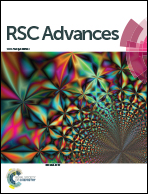Amine-rich ionic liquid grafted graphene for sub-ambient carbon dioxide adsorption
Abstract
The present study describes the synthesis of the adsorptivity based amine-rich ionic liquid (ARIL), namely, 3,5-diamino-1-methyl-1,2,4-triazolium tetrafluoroborate grafted graphene (HEG/ARIL), and its application in carbon dioxide adsorption. This ionic liquid occurs in the solid form at standard atmospheric temperature and pressure, and forms solid-like short range ordering on a graphitic substrate. Molecular vibrational spectroscopy suggests that the ARIL molecules are physically adsorbed on the graphene surface with no detectable chemical interactions. The CO2 adsorption on ARIL is not significantly accompanied by chemical interaction with the amine groups under sub-ambient conditions. The adsorption capacity of ARIL attained a significant improvement when it was grafted onto graphene. The favourability and energy of adsorption suggest that the cumulative interaction of CO2 with ARIL moieties is weaker than that with residual oxygen-containing functional groups in graphene. The adsorbate retention of graphene is largely increased upon grafting ARIL. The isosteric heat and entropy of CO2 adsorption on the HEG/ARIL is lower than that found on pristine HEG. Conclusively, ARIL functionalization improved the CO2 adsorption capacity and decreased the interaction energy between CO2 and graphene, because it enhances the density of the low affinity adsorption sites.


 Please wait while we load your content...
Please wait while we load your content...